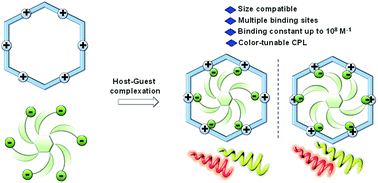Platinum(ii) metallacycles as highly affinitive hosts for dendritic amino acids with tunable circularly polarized luminescence†
Abstract
The incorporation of platinum(II) metallacycles into supramolecular chiral arrays has potential in introducing intriguing chiroptical activities and applications; however, it remains a considerable challenge due to their shape-persistent feature. Herein, we present the noncovalent modulation of supramolecular chirality in platinum(II) metallacycle-involved host–guest complexation. Tetraphenylethylene-based platinum(II) metallacycles were designed and synthesized, which exhibited aggregation-induced emission with fine-tailored luminescence colors. A hex-armed tyrosine derivative showed size matching towards the metallacycles. Driven by multiple electrostatic attractions, highly affinitive host–guest complexation occurred with 1 : 1 binding stoichiometry and a constant with a 108 order of magnitude. Host–guest complexation turned on the fluorescence of the metallacycles, which also appended chirality to the photoexcited state. Circularly polarized luminescence at different wavelengths was observed, benefiting from the robust complexation, realizing the noncovalent modulation of chirality to the platinum(II) metallacycles. This work establishes a strategy to transfer chirality via host–guest interaction to shape-persistent metallacycles with potential chiroptical applications.

- This article is part of the themed collection: Journal of Materials Chemistry C Emerging Investigators


 Please wait while we load your content...
Please wait while we load your content...